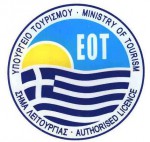The existence of human life during the Neolithic Period (6000-2600 BC) is proved by archaeological findings in the Ideon Andron cave on mountain Psiloritis, the Gerani cave west of Rethymno and the Elenon cave in the Amari district.
The great number of archaeological findings dating back to the Minoan period (2600-1100 BC) can be explained by the fact that human existence and activity became more common both in caves as well as in a variety of other dwelling places, the remains of which cover the entire area of the prefecture and are evidence of every stage of the Minoan period. Dating back to the Early Minoan Period (2600-2000 BC) in the Mylopotamos area are the Sfentoni cave in Zogiania and Pyrgi, Eletherna, in the Municipality of Rethymnon are the cities of Chamelevri, and Apothoulou in the Amari district.
The palatial installations on Monastiraki in the district in the district of the Amari, the settlements of Pera Gallinous in the Mylopotamous area, and Stavromenou as well as the caves of Melidoni and Patsos in the Municipality of Rethymnon date back to the middle-Minoan period. Finally, the cemetery of Armeni, the settlement of Zominthos in Anoghia and the place of worship on Fantaxospiliara in the village of Prinos date from the late Minoan Period (1600-1100 BC).
During the First Byzantine period (330-824) when the capital of the Roman Empire was transferred to the Byzantium and Constantinople was founded in 330, Crete was included in the East Roman Empire, constituting a separate district, which was governed by a Byzantine general. Henceforth Christianity expanded on the island, and in the 8th century the Cretan Episcopate was integrated with the Patriarchate of Constantinople. During the early Christian and First Byzantine period a large number of temples were built, archaeologists have discovered many of which.
Starting from the year 824 up until 961, the island was governed by the Arabs, although very little evidence of this fact was found in the area of Rethymno apart from some Arabian coins, which were found in the village of Giannoudi.
During the Second Byzantine period (961-1210) fortification works of the town of Rethymno were started for the first time as we shall see further on. In the year 1211 the long and interesting period of the Venetian occupation began, remains of which can clearly be seen still on all levels in the area of the town of Rethymno.
Crete’s liberation by Nikiforos Foka in 961, followed by its re-integration into the Byzantine Empire, signaled the beginning of the Second Byzantine Period, which lasted up until the arrival of the Venetians on the island in 1204. At that stage a fortified wall was built around all the buildings, thus constituting the first fortified settlement, the so-called „Castrum Rethemi“, which the Venetians later called Castel Vecchio.
The period of the Venetian occupation formally began in 1204, when Crete was passed over to Bonifatius of Montferrato, who later handed it over to the Venetians. However, in 1206 the Genoese pirate Enrico Pescatore invaded the island, and it was not until as late as 1210 that the Venetians actually succeeded in regaining control of Crete again. The Cretans were in opposition to their conquerors, which resulted in a series of revolutions during the period between 1211 and 1367.
Despite the Cretan resistance, the Venetians embarked on successive administrative changes, according to which the island was initially divided into six, and later, during the 14th century, into four sections, with the capitals Chania, Rethymno, Chandakas and Sitia. The Duke (Duca), who had his seat in Chandakas, had sovereign power over the entire island.
Rectors (Rettore), who were supported by two Councillors (Consiglieri), were in administrative command of the districts of Chania, Rethymno and Sitia.
After the fall of Constantinople in 1453 the position of the Venetians in the East was gradually weakened.
As early as in 1537/38, the architect Michele Sanmicheli from Verona was entrusted with a programme of fortification works, which had already been initiated by the town of Rethymno. His drafts included the land wall of the town, on which the construction works were started in 1540 and completed in 1570.
Chaireddin Barbarossa looted the village of Apokorona, the surrounding villages of Chania, and the towns of Rethymno and Sitia. The attack of the pirate Ulutz-Ali on 7 July in 1571 devastated Rethymno. The Turks found the town deserted, whereupon they plundered it and set it on fire.
Most of the houses were burnt; the walls of the Castel Vecchio as well as the land wall, which had only been completed a short time before, had vanished. As a result of these events it was decided to build a fortress on the hill of Palaiokastro, the walls of which should also protect the houses of the town. In 1573, the foundation works of the fortress were realised under the leadership of the Rector Alvise Lando. The architect Sforza Pallavicini drew the initial plans, whilst the supervising mechanical engineer was Gian Paolo Ferrari.
After the fortress had been completed they realised that the space was actually too small to house all the buildings. Consequently it was decided that only the Venetian administration, the Latin Episcopate and the Military authorities should be accommodated within the fortress, while it should merely serve as a place of shelter for the inhabitants in case of emergency.
After several years, when the fortress, the so-called Fortezza, was completed, the Venetians had secured a powerful position on the island. Thus, towards the end of the 16th century the city achieved characteristics of the Renaissance according to Venetian examples.
This stage included the construction of luxurious public and private mansions, while at the same time the city achieved a central square (piazza) as did the city of Venice, a club house of the nobility (Loggia), fountains such as the Rimondi fountain, a large sundial, a central street, as well as smaller by-passing roads, which led to the temples, the monasteries, the mansions and the simple houses. Those magnificent buildings were ornamented with a variety of doorframes, some of which were kept simple, whereas others were greatly decorated.
hey have been preserved up until today and give evidence of that brilliant stage in history of the city of Rethymno. During that atmosphere of Renaissance, in which the Hellenic element definitely excelled, the union of two civilisations was accomplished, which influenced the intellectual and artistic domain to a large degree. Scholars such as Markos Mousouros, Zacharias Kalliergis and the brothers Vergikios were highly esteemed in Europe, whilst G. Hortatzis, Troilos and Marinos Tzane Bounialis, the poet of the Cretan War, contributed to the flourishing Cretan literature and were rewarded for their achievements.
On a similar line, Emmanuel Lambardos and Emmanuel Bounialis, both of who were worthy representatives of the so-called Cretan School, also expressed the era of Renaissance in the art of painting.
In 1645 the first Turkish troops landed at Chania and besieged the city immediately. After two months the city surrendered and the great Venetian-Turkish Wars of the 17th century had started.
On 29 September 1646 the troops of Hussein Pasha arrived at the fortified walls of the city of Rethymno. These walls had already been weakened because of the many earlier raids led by the Turks, who had previously established themselves in the area of Chania.
Citizens and civilians gathered inside the fortress, where the situation had reached dramatic dimensions due to the plague, the injured, the lack of food and most importantly the lack of ammunition.
When the Governor realised that the town could no longer be defended, he raised the white flag and negotiated the capitulation of the city of Rethymno – fortunately on favourable conditions: any of the inhabitants who wished to go to Chandakas were transferred there, while those who wished to stay became subjects of the Sultan.
The Fortezza of Rethymno was surrendered to the Turks on 13 November 1646.
The domination of the Turks over the inhabitants of Rethymno (1669-1898) as well as over the rest of Crete, brought many important changes not only in the administrative, economic and population areas, but also in the intellectual and every-day life of the people. By that time the island of Crete was considered large enough to initially be divided into three regions, that of Chandakas, of Rethymno and of Chania, to which that of Lassithi was added later. None of these regions were governed by a Pasha. The image of the town changed radically.
The conquerors installed themselves in the Venetian mansions, which they decorated with their own architectural elements. At the same time they started building mosques and minarets, which further emphasised their presence. The so-called „sachnisia“, wooden balconies projecting from the façade of the buildings, suddenly appeared in the former Venetian alleys and network of streets, thus giving the city a new character – that of a Moslem town.
Many churches were destroyed; others were turned into mosques. As could be expected, these acts led to an intellectual decline. The period of the „Cretan Renaissance“ with its flourishing literature and fine arts belonged to the past. Christians were slaughtered and their properties plundered, which resulted in a series of uprisings and revolutions started by the Cretans, among which the most important took place in 1821 in the framework of the general uprising of the Greek people against the Turkish subjugators.
However, the Cretans did not succeed in obtaining their freedom in the revolution of 1821. Instead the island was assigned to the Egyptian Vice-Roy Mechmet Ali (1830-1841), a fact, which gave only small relief for the Christian inhabitants of the island, who continued to fight for their freedom. Over the years their continuous struggles showed a few results with regard to privileges concerning the freedom of religion and the right of holding property.
However, the Cretans were not satisfied unless they were completely liberated and united with the Greek mainland. A crucial battle was fought during the Great Cretan Revolution, which lasted for three years, from 1866 to 1869, and during which the holocaust of the Arkadi Monastery took place. Even after this shattering event and their crucial battle for freedom, the Cretans continued to be dominated by the Turks with no change to their situation. Therefore, another revolution followed, that of 1878, and as a result of this one they achieved several religious and political privileges, the most important of them being that a Cretan was allowed to be the General Governor of Crete.
However, this did not mean that the situation improved henceforth. On the contrary, from 1890 to 1895 the Turks showed an even more merciless attitude towards the locals, which resulted in the revolution of 1897, and due to this revolution the Cretans finally secured their autonomy






 Location: Agios Pavlos, Sakturia, Rethymno, Crete, Greece
Location: Agios Pavlos, Sakturia, Rethymno, Crete, Greece Phone: +30.2832071104
Phone: +30.2832071104 Mobile: +30.6973328974
Mobile: +30.6973328974  Fax: +30.2832071105
Fax: +30.2832071105 Email: info@agiospavloshotel.gr
Email: info@agiospavloshotel.gr